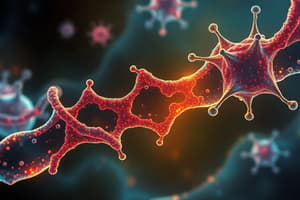Podcast
Questions and Answers
Define the structure of the antibody.
Define the structure of the antibody.
Which antibodies are found on immature B Cells?
Which antibodies are found on immature B Cells?
- IgM (correct)
- IgE
- IgG (correct)
- IgA
Define the answer.
Define the answer.
4 is correct.
The light chains don't change.
The light chains don't change.
How is diversity achieved with respect to antibodies?
How is diversity achieved with respect to antibodies?
Define the chromosomal arrangement of the heavy and light chain genes.
Define the chromosomal arrangement of the heavy and light chain genes.
Notice the relative position of the heavy chain constant region of genes.
Notice the relative position of the heavy chain constant region of genes.
Describe the diversity by combinatorial diversity.
Describe the diversity by combinatorial diversity.
Review this slide.
Review this slide.
What are the rules of recombination?
What are the rules of recombination?
What is the 12/23 rule?
What is the 12/23 rule?
Describe this slide.
Describe this slide.
How does junctional diversity occur?
How does junctional diversity occur?
Review.
Review.
Continue review.
Continue review.
What is Allelic exclusion?
What is Allelic exclusion?
Review this slide.
Review this slide.
Review in detail.
Review in detail.
What has to happen to complete class switching?
What has to happen to complete class switching?
What determines the class switching?
What determines the class switching?
Define the cytokine stimulation.
Define the cytokine stimulation.
Review.
Review.
Answer this class question.
Answer this class question.
Define the somatic hypermutation, which introduces base changes in the antibody V region.
Define the somatic hypermutation, which introduces base changes in the antibody V region.
What leads to AID transcription?
What leads to AID transcription?
What is AID?
What is AID?
How does AID of cytosine to uracil lead to hypermutation?
How does AID of cytosine to uracil lead to hypermutation?
What is an AID deficiency?
What is an AID deficiency?
What is the structure of T Cell Receptor?
What is the structure of T Cell Receptor?
Review the summary...many times.
Review the summary...many times.
Wait, there is more review:
Wait, there is more review:
Inheritance of multiple C gene segments does not contribute to the generation of diversity of B-cell antigen receptors?
Inheritance of multiple C gene segments does not contribute to the generation of diversity of B-cell antigen receptors?
Of what is the antibody-binding site primarily composed?
Of what is the antibody-binding site primarily composed?
During the maturation of a B lymphocyte, what is the first immunoglobulin heavy chain synthesized?
During the maturation of a B lymphocyte, what is the first immunoglobulin heavy chain synthesized?
B-cell differentiation involves rearrangement of heavy-chain gene segments?
B-cell differentiation involves rearrangement of heavy-chain gene segments?
What is the 12/23 rule?
What is the 12/23 rule?
A V, D, and J segment will only arrange with another gene segment that has the corresponding 12 or 23.
A V, D, and J segment will only arrange with another gene segment that has the corresponding 12 or 23.
Flashcards are hidden until you start studying
Study Notes
Antibody Structure
- Antibodies consist of heavy and light chains connected by disulfide bonds, featuring variable regions for antigen binding and constant regions for biological activity.
B Cell Antibodies
- Immature B cells express Immunoglobulin M (IgM) and Immunoglobulin G (IgG) on their surface.
Light Chain Stability
- The structure of light chains remains stable and does not change throughout B cell differentiation.
Antibody Diversity
- Diversity in antibodies is achieved through combinatorial diversity, including the joining of different heavy and light chain gene segments and junctional diversity from rearrangements during recombination.
Gene Arrangement
- The configuration of heavy and light chain genes involves both segments that are arranged on different chromosomes, with specific positions for heavy chain constant regions affecting antibody type.
Recombination Process
- Recombination events involve rearrangements, shifts, and deletions in gene segments, crucial for generating diverse antibody repertoires.
Recombination Rules
- Following the 12/23 rule, recombination can only occur between RSS sequences that have a 12 base pair or a 23 base pair spacer, ensuring correct gene segment arrangement.
Junctional Diversity
- Junctional diversity is a major contributor to antibody variability, thanks to nucleotide addition and deletion during recombination.
Allelic Exclusion
- Allelic exclusion ensures that a B cell expresses only one heavy chain and one light chain from either parental allele, promoting uniformity in antibody specificity.
Class Switching
- Class switching requires specific signals and is influenced by cytokine stimulation, determining the antibody type produced (e.g., IgA, IgE).
Somatic Hypermutation
- Somatic hypermutation introduces point mutations in the variable region of immunoglobulin genes, enhancing the affinity of antibodies for their antigens.
Activation-Induced Cytidine Deaminase (AID)
- AID is an enzyme that plays a crucial role in somatic hypermutation and class switch recombination by converting cytosine residues to uracil.
AID Deficiency
- Deficiency in AID can lead to immunodeficiency, as effective antibody diversity and affinity maturation are impaired.
T Cell Receptor Structure
- T Cell receptors are structurally similar to antibodies but are composed of alpha and beta chains, specific for recognizing peptide antigens presented by Major Histocompatibility Complex (MHC) molecules.
B Cell Development and Antibody Production
- During B cell maturation, the first immunoglobulin heavy chain synthesized is the mu heavy chain, crucial for producing the IgM antibody.
B Cell Differentiation
- B cell differentiation is characterized by rearrangements of heavy-chain gene segments, initiating in the bone marrow.
Antigen Binding Site
- The antibody binding site is primarily formed by hypervariable regions of both heavy and light chains, critical for specific antigen recognition.
C Gene Segments
- Inheritance of multiple constant (C) gene segments does not impact the diversity of B-cell antigen receptors but contributes to different antibody isotypes.
Studying That Suits You
Use AI to generate personalized quizzes and flashcards to suit your learning preferences.



